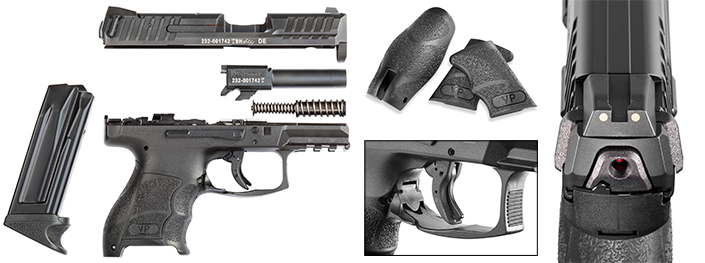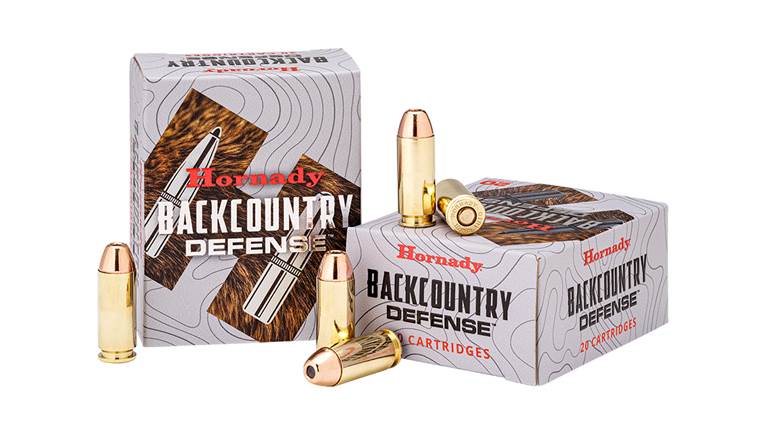
When any handgun maker offers a full-size service pistol, typically it quickly starts work on a follow-up model. It is a familiar pattern, and the subsequent model is invariably a shorter-barrel, shorter-frame version of the full-size gun. Most of the former are well-suited for police and military handgunners and even some civilian applications. But the strong and steady demand for smaller guns intended for concealment use by military and police shooters is probably exceeded these days by the demand of legally armed citizens. In record numbers Americans are exercising their constitutional right to not just keep, but also bear arms.
Two criticisms often leveled at Heckler & Koch are the price of its guns and that it does not produce enough offerings well-suited to concealment. The company has already addressed the former, and the latter is the subject of this article.
Enter the competitively priced H&K VP9SK in 9 mm Luger. A couple of years ago, the respected German gunmaker uncharacteristically offered a new full-size, polymer-frame, striker-fired pistol, the VP9, in 9 mm Luger and .40 S&W (January 2015, p. 58). The follow-up gun was introduced at the 2017 SHOT Show in Las Vegas, Nev. It is a shorter, lighter and more compact version of the VP9, as well as a model well-suited for concealed carry. For brevity’s sake, I will refer to the gun as the “SK.” As did the parent gun, the SK uses a molded polymer receiver and steel upper. It is chambered for the world’s most popular pistol cartridge, the 9 mm Luger, in both regular and +P loadings. Standard SK magazines hold 10 cartridges in a staggered-column arrangement.
Like the modern service pistols of most makes, the trigger system offers consistent weight and travel with every pull. Operational controls are a bilateral slide lock/release and H&K’s trademark bilateral magazine release—paddles that conform to the lower rear edge of the trigger guard. The SK’s dimensions are 6.61" in length by 4.57" in height by 1.31" in thickness, compared to the 7.34"x5.41"x1.31" dimensions of the original VP9. The new SK weighs 23.1 ozs., down from the 26.6 ozs. of its forebear.
The SK is a recoil-operated pistol with a 3.39"-long tilting barrel (with H&K’s polygonal rifling) that features a squared breech end. An under-barrel cam tilts the barrel up as the slide closes in the regular operating cycle. The squared rear of the barrel engages the wide ejection port, locking the barrel to the slide. It’s a simple and rugged arrangement, and used by many pistols. The pistol’s trigger is a single-action type, where the internal striker is fully cocked by the action of the slide’s movement, either manually or under recoil.
The internal workings and trigger action of the SK will be familiar to H&K users—as will some of the company’s unique ergonomic touches. That starts with a frame of molded polymer, which allows the maker to shape it with complex, curved lines, rounded surfaces and stippling that would be cost prohibitive in a metal frame. In so doing, H&K managed to come up with a pistol that is more ergonomically sound than just about anything else available. I reviewed the original VP9 pistol several years ago, and was impressed with its design. If anything, the SK version is a little more pleasing to shoot. Of course the slide rails in the receiver, as well as lockwork and contact surface that cams the barrel into battery, are made of steel. The fire-control parts are contained in a metal chassis that is fixed within the serialized frame.
The SK is ready to go, out of the box, but its frame can be adapted to a specific hand size through rather clever engineering. The shape of the grip can be altered by way of replaceable inserts that fit into recesses on its sides and backstrap. While the gun comes with “medium” side panels and backstrap installed, they can be easily replaced with “large” or “small” inserts. Choose whichever size feels right. With three choices for each location, it’s three times three times three for a total of 27 different configurations. Changing from one to the other is simple—drive out one pin and slide all panels off the frame. We’ll look at this feature again when we take the SK to the range. As with cleaning the SK, the shooter should ensure the pistol is not loaded and all ammunition is away from the work bench when reconfiguring the grip.
Good frame ergonomics go beyond the multiplicity of grip configurations in butt shape. There are two shallow finger grooves on the frontstrap, as well as a useful trigger-approach recess on either sides of the frame. And, included with the SK are two 10-round magazines, one with a flush-fitting baseplate and the other sporting an extended floorplate with a third finger groove to accommodate the shooter’s little finger for maximum control. Most of the SK’s contact surfaces are a grained or stippled finish that comfortably adheres to the hand to provide a positive grasp.

There is one feature on the slide, though, that puts the gun in a class of its own. The SK’s slide already possesses panels of cocking serrations, front and rear. In addition, at the back edge of the rear panel, on both sides, there are raised bars raked at the same angle as the serrations. Visually, the bars blend into the blued steel of the slide. In hand, however, they are instantly noticeable when you grasp and rack the slide to cycle the action or to check the chamber.
Heckler & Koch calls these little raised bars “charging supports”—I call them a great idea, and I expect they are going to be copied in some form by competitors. They offer a real advantage over the typical arrangement of shallow serrations when applying rearward force against the gun’s recoil spring. Consider what the hands have to do when racking the slide. The left hand reaches over the pistol and takes an overhand grip on the slide. On a traditional pistol, you have to get a firm grip on the pistol with the left thumb and index finger before you can move the slide back. Much of the effort is in an inward squeezing motion, before you can pull back on the slide. Some shooters just have problems doing this, and the SK helps them with a small, angled ledge to pull against. It really works. And, if for some reason you don’t care to use them, you can simply take them off.
The SK’s controls are simplified for tactical/defensive use. To fire a loaded pistol, just pull the trigger. There are no manual safeties to be manipulated, but there is an articulated trigger safety and an internal drop safety, both passive. A simple and direct piece of equipment, the SK is also bilateral in operation; there are slide locks on both sides of the pistol, and the magazine release can be manipulated with either hand. The mechanism consists of a single contoured bar that runs across the lower rear corner of the trigger guard, with contact paddles on both sides. You can drop the magazine with the trigger finger or the thumb of either hand. The company developed this feature a few years back, and it’s employed on a number of H&K’s guns.
The sample SK delivered 100 percent reliability with an assortment of quality ammunition—no malfunctions of any kind. Shooting with the gun sideways or upside down, limp-wristing or weak-gripping the SK had no effect on the pistol’s functioning. Magazines loaded with mixed ammunition—from 115-grainers to 147s—all ran through the gun with aplomb. The trigger pull is a bit creepy, but I was able to shoot with accuracy off the bench. Trigger reset is longer than some. None of this worries me in commending the gun for defensive use. As to handling, I am convinced that the 10-shot magazine with the extended floorplate should be the one to use if at all possible. The gun is light and short, so powerful loads crank up the recoil and muzzle flip. If you can get your little finger in on the gripping equation, the shooting will be quicker, because you have far better control.
Because a concealed-carry pistol is always carried more than fired, I can understand keeping the more concealable, flat-bottomed 10-round magazines in the gun, but its owner’s manual also depicts 13- and 15-rounders. While they were unavailable at the time of writing, Heckler & Koch advised that both would be available by the time of publication. With the addition of a collar on its bottom, the 15-round P30/VP9 magazine may be used in the VP9SK as well.
My local range had no business on a warm summer day, and there was ammunition on hand, so I tried some of the 27 combinations of side panels and backstraps. Switching and swapping only takes a minute or two once you get used to it. So, I tried one of the Elmer Keith-style arrangements where the pistol’s grip grows thicker on the palm side and thinner on the fingertip side. It works like a charm. With a small left panel and large right panel, plus a small backstrap, I had a very different-looking gun. To a most noticeable degree, I was able to control the gun better than any other combination that I tried. Maybe the old gunwriter was on to something.

In this very reliable new pistol, Heckler & Koch offers a great handgun for the concealed carry handgunner. It represents a new direction for the company, which just completed a huge new facility in Columbus, Ga., and that pivot is expected to result in a U.S. operation that has renewed dedication to commercial sales. The company apparently decided that if it planned to make such a change it needed a gun fresh enough to call attention to itself. The VP9SK is that gun—in fact, I believe it might be the best H&K pistol yet.








































